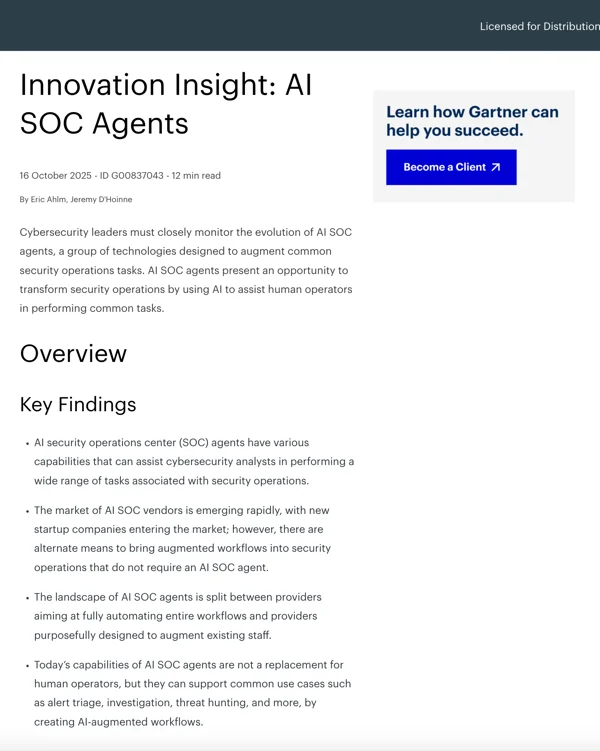
-min.webp)
The first 15 minutes of an investigation often set the tone. In a traditional SOC, those minutes are spent pulling data from multiple tools, checking correlations, and confirming whether the alert is even worth pursuing. With AI in the mix, those 15 minutes look very different. The system surfaces evidence, suggests next steps, and frees analysts to focus on judgment instead of grunt work. Preparing your team for that shift is one key part of what makes an AI-powered SOC succeed.
AI is reshaping how SOC analysts create value. Instead of spending hours triaging alerts or enriching logs, analysts now focus on higher-order work: validating AI-generated insights, determining the right response, and strengthening proactive defenses. For junior analysts, this accelerates the path into meaningful, higher-value contributions. For senior analysts, it opens room for strategic threat hunting and deeper, long-term investigations.
Crucially, the analyst’s role is not to echo the machine, but to guide and challenge it. AI serves as a force multiplier, investigating at scale, surfacing hidden patterns, and accelerating response. Analysts contribute the judgment, contextual awareness, and adversarial mindset that machines lack. Together, this partnership elevates investigations from quick pattern matching to meaningful, outcome-driven security decisions.
{{ebook-cta}}
As roles evolve, preparation must evolve too. Analysts need new skills: interpreting AI findings, spotting blind spots, and applying critical thinking through hypothesis testing and adversarial analysis.
With AI now supporting natural language threat hunts and investigations, training should teach analysts how to leverage conversational interfaces effectively. Teams should learn to frame investigative questions in plain language, follow up with targeted queries, and adapt their lines of inquiry rapidly as new information appears. This approach requires creativity, curiosity, and comfort iterating in partnership with the AI. This enables both junior and senior analysts to probe deeper, pivot quickly, and identify emerging threats more efficiently.
There’s a risk of skill atrophy if analysts only echo what AI tells them. Teams must practice challenging AI, exploring alternative paths, and asking deeper questions. In other words, AI should raise the bar, not lower it. The best SOCs use AI to accelerate learning and develop junior analysts faster, not to deskill the team.
Onboarding should increasingly emphasize human-AI collaboration: how to frame precise questions for AI, interpret uncertainty in its answers, and know when to press deeper than the system’s surface-level insights.
In the future, success in the SOC will hinge on mastering this collaborative dynamic: guiding AI-driven investigations while applying uniquely human creativity, skepticism, and intuition.
Teams don’t want a 7th “single pain of glass.” For AI to deliver real value in the SOC, it must fit naturally into daily operations. If outputs live in a separate platform, analysts will hesitate to use them. Findings should appear directly within the tools where analysts already investigate, escalate, and respond. This makes it easier to act on AI-driven insights without breaking focus or switching contexts.
Integration should be tested with live alerts to ensure the process feels natural under real conditions. When the flow between human judgment and AI assistance is smooth, analysts gain confidence in the system and are more likely to rely on it during critical decision-making.
Leaders can track progress by looking at workflow adoption. The goal is not adding another product into the stack, but embedding AI so effectively that it becomes part of the operating rhythm of the SOC.
Strong AI outcomes depend on the environment it runs in. If visibility is limited, blind spots will appear and investigations will miss context. To prevent this, connect AI to the full range of security data sources across identity, cloud, endpoint, email, SIEM, SaaS, and more. Partial access produces partial answers.
Governance is equally important. Begin with read-only access for investigations, and expand permissions as confidence grows. Apply the same principles used for human analysts, ensuring access is role-based and auditable.
When AI has broad visibility and clearly defined permissions, it provides sharper insights, reduces noise, and helps analysts carry out investigations with greater speed and confidence.
AI systems improve most when paired with engaged analysts. Each correction, challenge, or clarification an analyst provides helps tune the model to the SOC’s data and threat landscape. A deliberate feedback cycle ensures AI adapts to real conditions, while analysts strengthen their investigative instincts by testing and refining the system’s reasoning. Over time, this exchange builds accuracy, efficiency, and trust in daily operations.
Adopting AI in the SOC is about elevating people, not replacing them. AI should automate repetitive tasks, surface relevant patterns, and provide clear context to support fast, informed decisions. It should be transparent, easy to challenge, and guided by analyst expertise.
Leaders should make it clear that success comes from using AI to unlock new investigative techniques and encourage continuous learning. When teams see AI as a tool that amplifies their skills and drives growth, morale improves, trust builds, and the SOC is positioned for future leadership in security.
Get Gartner's guidance on evaluating and adopting AI SOC agents

